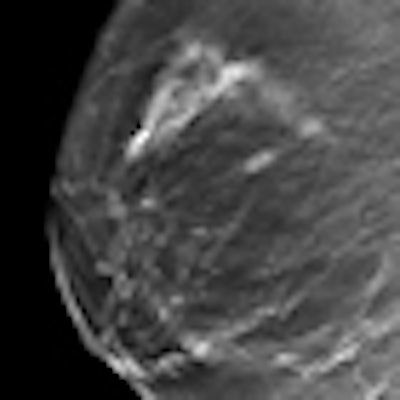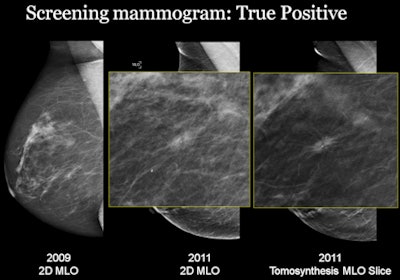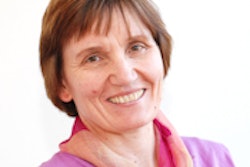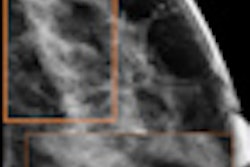
CHICAGO - Adding digital tomosynthesis to mammography for screening lowers recall rates by at least a third -- particularly in younger women or those with dense breast tissue, according to a scientific session given Monday afternoon at the RSNA meeting.
"Tomosynthesis offers great promises, such as increased conspicuity of lesions and reduced false positives from overlapping tissue," study presenter Dr. Brian Haas, of Yale School of Medicine, told session attendees. "And the potential benefits for patients include reduced recall rates and improved cancer detection rates. We conducted our study because there is currently limited data about the performance of tomosynthesis in clinical practice."
Haas and colleagues sought to identify not only how the combination of tomosynthesis and FFDM affected recall rates, but which types of patient populations enjoyed the greatest reductions.
The study included all patients who presented for screening mammograms between October 2011 and September 2012 at four clinical sites: an academic teaching hospital, two outpatient radiology offices, and a mobile van unit. Digital tomosynthesis was available at the academic teaching hospital and one of the outpatient radiology offices; patients at these two sites were offered screening with tomosynthesis (Selenia Dimensions, Hologic) as well as conventional digital mammography, while patients at the other two sites had digital mammography alone. Women with breast implants or large breasts requiring tiled images were not included in the study.
Of 13,174 patients, 6,116 (46%) received tomosynthesis in addition to FFDM, while 7,058 (54%) received conventional mammography alone. Haas' team found that the reduction in recall rates ran across all tissue density and age groups, with the overall recall rate for patients in the 3D-plus-2D group at 8.4%, compared with 11.7% for conventional imaging alone, a 28% reduction.
But younger women and those with dense breasts -- the populations in which mammography can miss cancers -- benefited the most. For women with heterogeneously dense breasts, using tomosynthesis with FFDM cut the recall rate by 37.8%, from 16.3% (FFDM alone) to 10.1%. Women with extremely dense breasts saw the recall rate decrease from 15.1% to 6.4% -- a 57.6% reduction -- while women younger than 40 saw a decrease from 24.8% to 11%. In women between the ages of 40 and 49, the recall rate fell from 16.4% to 10.4%.
 |
| Tomosynthesis identified a spiculated mass, which was determined to be invasive ductal carcinoma. Images courtesy of Dr. Brian Haas, Yale School of Medicine. |
In terms of the overall cancer detection rate, the combination of tomosynthesis and FFDM was comparable to 2D mammography alone, at 5.6 per 1,000 and 5.2 per 1,000, respectively.
Haas acknowledged that the study had some limitations, including its retrospective design and lack of randomization -- that is, patients could opt out, and there were slightly different patient populations at each site. But the combination of tomosynthesis and FFDM carries many benefits for women at risk of missed cancers on mammography.
"Tomosynthesis promises to have a profound effect on the performance of screening mammography," Haas concluded.
Tomo: Also good for 'minimally dense' tissue?
In a related study presented during the same session, Spanish researchers found that the combination of tomosynthesis and FFDM did increase cancer detection -- from 1.5% to 2.3%.
Dr. Paula Martinez Miravete, of Area de Patología de Mama, Diagnóstico Médico, and colleagues included 5,718 combination studies performed between December 2010 and December 2011. Of these, Miravete's group classified 5,603 cases into the American College of Radiology's (ACR) BI-RADS categories for breast parenchymal density of 2, 3, and 4.
Conventional digital mammography found 133 breast tumors. Tomosynthesis detected 47 additional cancers that mammography missed; nine of these were BI-RADS density category 2, 20 were category 3, and 18 were category 4.
Adding tomosynthesis to 2D mammography improved the detection rate, and because there were no significant differences among the three ACR BI-RADS density patterns, the combination could be useful not only in more dense categories, but also in category 2, or minimally dense tissue, Miravete's group said.




















